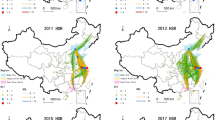Abstract
Cities separated in space are connected together by spatial interaction (SI) between them. But the studies focusing on the SI are relatively few in China mainly because of the scarcity of data. This paper deals with the SI in terms of rail passenger flows, which is an important aspect of the network structure of urban agglomeration. By using a data set consisting of rail O-D (origin-destination) passenger flows among nearly 200 cities, inter-city rail distance O-D matrixes, and some other indices, it is found that the attenuating tendency of rail passenger is obvious. And by the analysis on dominant flows and spatial structure of flows, we find that passenger flows have a trend of polarizing to hubs while the linkages between hubs upgrade. However, the gravity model reveals an overall picture of convergence process over time which is not in our expectation of integration process in the framework of globalization and economic integration. Some driven factors for the re-organization process of the structure of urban agglomeration, such as technique advance, globalization, etc. are discussed further based on the results we obtained.
Similar content being viewed by others
Change history
17 June 2020
A Correction to this paper has been published: https://doi.org/10.1007/s11769-020-1132-1
References
Chan Roger C K, 1996. Urban development strategy in an era of global competition: The case of south China. Habitat International, 20(4): 509–523.
Chen Hang, Zhang Wenchang, Jin Fengjun et al., 2000. Geography of Chinese Transportation. Beijing: Science Press, 193–194. (in Chinese)
Fotheringham A S, O’Kelly M E, 1989. Spatial Interaction Models: Formulations and Applications. Dordrecht and Boston: Kluwer Academic Publishers.
Gu Chaolin, 1992. Chinese Urban System: History, Current Situation and Prospect. Beijing: The Commercial Press, 275–313. (in Chinese)
Huang Haibo, He Lin, 1999. Research of passenger transport demand among cities. Journal of the China Railway Society, 21(5): 5–9. (in Chinese)
Jin Fengjun, Wang Fahui, Liu Yu, 2004. Geographic patterns of air passenger transport in China 1980–1998: Imprints of economic growth, regional inequality, and network development. The Professional Geographer, 56(4): 471–487.
Laurence J, Ma C, 2005. Urban administrative restructuring, changing scale relations and local economic development in China. Political Geography, 24(4): 477–497.
Li Xuewei, Zhao Xingang, 2004. Input-output Analysis on Chinese Railways. Beijing: China Railway Publishing House, 115–149. (in Chinese)
Lu Dadao, 2003. The Theories and Practices of Chinese Regional Development. Beijing: Science Press, 334–371. (in Chinese)
Mikkonen K, Luoma M, 1999. The parameters of the gravity model are changing—how and why? Journal of Transport Geography, 7(4): 277–283.
Murayama Y, 1982. Canadian urban system and its evolution process in terms of air-passenger flows. Geographical Review of Japan, 55(6): 380–402.
National Bureau of Statistic of China, 1992, 1996, 2001, 2006. Urban Statistical Yearbook of China. Beijing: People’s Communications Press. http://www.stats.gov.cn. (in Chinese)
O’Kelly M E, 1998. A geographer’s analysis of hub-and-spoke networks. Journal of Transport Geography, 6(3): 171–186.
Qi Kang, Duan Jin, 1997. An analysis on China’s urbanization and urban agglomerations. Urban Planning Forum, (1): 1–4. (in Chinese)
Simon X, Zhao B, Roger C et al., 2003. Globalization and the dominance of large cities in contemporary China. Cities, 20(4): 265–278.
Taaffe E J, Gauthier H L, O’Kelly M E, 1996. Geography of Transportation (2nd edition). New Jersey: Prentice Hall Inc., 195–230.
Yearbook House of China Transportation and Communications, 1992, 1996, 2001, 2006. Year Book of China Transportation & Communications. Beijing: People’s Communications Press. (in Chinese)
Zhang Wenchang, Jin Fengjun, Rong Chaohe et al., 1992. Spatial Transport Linkage: Theoretical Study, Empirical Analysis and Forecasting Methods. Beijing: China Railway Publishing House, 56–64. (in Chinese)
Author information
Authors and Affiliations
Corresponding author
Additional information
Foundation item: Under the auspices of Key Project of National Natural Science Foundation of China (No. 40635026)
This article has been retracted at the request of the authors. The work presented in this article was previously published in Chinese. All authors agree to this retraction.
About this article
Cite this article
Dai, T., Jin, F. RETRACTED ARTICLE: Spatial interaction and network structure evolvement of cities in terms of China’s rail passenger flows. Chin. Geogr. Sci. 18, 206–213 (2008). https://doi.org/10.1007/s11769-008-0206-2
Received:
Accepted:
Published:
Issue Date:
DOI: https://doi.org/10.1007/s11769-008-0206-2



